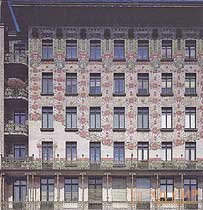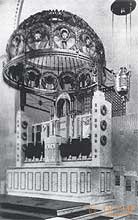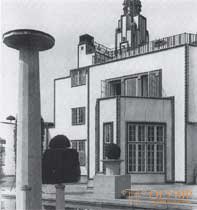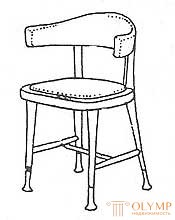
Stylistic current in art of Austria of the Modern period of the end of the XIX - beginning of the XX centuries  The name arose from the fact that at that time the art of Vienna, like that of the other center of art, Munich, embodied in the best form the most advanced artistic ideas of Southeast Europe. The city lived in a musical rhythm. Vienna architecture of the period of Historicism of the middle and second half of the XIX century. in the works of G. Semper and K.E. von Hase-Nauer approached the solution of new urban problems. “Articles of applied art, created in this city that knows no fuss, testified to Vienna’s inherent culture and unconstrained humor. They were distinguished by a rich decoration of surfaces, sometimes even excessive, which was combined with skillful detailing and often bold, even rough selection of colors ...
The name arose from the fact that at that time the art of Vienna, like that of the other center of art, Munich, embodied in the best form the most advanced artistic ideas of Southeast Europe. The city lived in a musical rhythm. Vienna architecture of the period of Historicism of the middle and second half of the XIX century. in the works of G. Semper and K.E. von Hase-Nauer approached the solution of new urban problems. “Articles of applied art, created in this city that knows no fuss, testified to Vienna’s inherent culture and unconstrained humor. They were distinguished by a rich decoration of surfaces, sometimes even excessive, which was combined with skillful detailing and often bold, even rough selection of colors ...
The epithet that could be applied to these products also applies to the crowns themselves. They were charming. ” As in eclectic architecture, this diversity, color redundancy and diversity of decor, saturation with ornaments in different ethnic traditions of the countries that comprised the Austro-Hungarian Empire - Bohemia, Moravia, Croatia, Dalmatia, Galicia, Bosnia - stimulated artists to a sharp turn from remnants Biedermeier and the "Ringstrasse style" to a strict and rational "new English style."  In 1858, the Grand Duke Reiner commissioned R. von Eitelberger to develop a plan of institutions for Vienna, the first in continental Europe, on the model of the South Kensington Museum and the art and industry school created in England by G. Semper. Next year, the first exhibition of the Imperial and Royal Museum of Art and Industry opened. In 1867, the School of Arts and Crafts was created in Vienna, headed by architect Otto Wagner (1841-1918), after which it became the leader in Europe.
In 1858, the Grand Duke Reiner commissioned R. von Eitelberger to develop a plan of institutions for Vienna, the first in continental Europe, on the model of the South Kensington Museum and the art and industry school created in England by G. Semper. Next year, the first exhibition of the Imperial and Royal Museum of Art and Industry opened. In 1867, the School of Arts and Crafts was created in Vienna, headed by architect Otto Wagner (1841-1918), after which it became the leader in Europe.
Wagner was an outstanding architect, creator of a new Viennese school of architecture, a theorist and teacher. In 1894-1914 He taught at the Vienna Academy of Fine Arts, where, developing the ideas of rationalism, he educated a whole generation of Viennese Art Nouveau artists, among them: J. Koter, I. Hoffmann, M. Fabiani, I. Plecnik, P. Janak. In 1898, the Vienna branch of Secession was founded in protest against the academic routine. The following year, he was joined by O. Wagner. "The style of practical utility" (it. Nutzstil), developed by Wagner and his students, combined simple geometric shapes with a minimum of decor. This style was different from the winding lines of the “scourge”, invented by A. Van de Velde and V. Horta in Brussels and X. Obrist in Paris. Viennese artists gave the world their regional version of Art Nouveau, little resembling the style of the French-Belgian Art Nouveau. Viennese Art Nouveau was influenced by both English and Oriental art. In 1898, an exhibition of 18th-century English furniture, the products of the workshops of T. Chippendale, J. Hepplewite and T. Sheraton, was held in Vienna. In 1901, the exhibition of the Scottish artist C. Mackintosh and the products of his "school of Glasgow."
The influence of the Wagner school affected the addition of the style of St. Petersburg and Moscow Modern, it is noticeable in many works by F. Shechtel in Moscow. The style of straight lines, squares, circles, and the “chess cell” is characteristic of the work of Joseph Hoff-mann (1870-1956), the best student of O. Wagner and the organizer of the Vienna Workshops.  For his passion for the geometric forms of this artist, he was called the “board”, “square Hoffmann” (“Quadratl Hoffmann”). In 1912, Hoffmann founded the Austrian Verkbund, a type of Germanic union of industrialists and artists. The best and most characteristic work of Hoffmann-architect is the house of the banker and art collector A. Stoklö in Brussels (1905-1911). Using a variety of combinations of clean planes, lined with marble, squares and straight lines, protrusions and rhythmic "shifts", the architect created an expressive image in the style of the geometric current of Modernity. Stoklö House is called the “Museum of Secessionism”. Many artists of the Vienna Workshops took part in the design of its interiors: G. Klimt, K. Moser, M. Povolni, F. Metzner, R. Lukš, E. Makovskaya.
For his passion for the geometric forms of this artist, he was called the “board”, “square Hoffmann” (“Quadratl Hoffmann”). In 1912, Hoffmann founded the Austrian Verkbund, a type of Germanic union of industrialists and artists. The best and most characteristic work of Hoffmann-architect is the house of the banker and art collector A. Stoklö in Brussels (1905-1911). Using a variety of combinations of clean planes, lined with marble, squares and straight lines, protrusions and rhythmic "shifts", the architect created an expressive image in the style of the geometric current of Modernity. Stoklö House is called the “Museum of Secessionism”. Many artists of the Vienna Workshops took part in the design of its interiors: G. Klimt, K. Moser, M. Povolni, F. Metzner, R. Lukš, E. Makovskaya.
If O. Wagner and I. Hoffmann did not deny the possibility of traditional forms of decor and ornamentation, then the Austrian architect A. Loos (1870-1933) generally refused any “ornaments like children's babbling of painting” and “savage art”.  Loos studied architecture in Dresden, Paris, New York and Chicago and, with his daring “American projects”, laid the foundations of a new trend even before the First World War. I. Olbrich (1867-1908) was not officially a student of O. Wagner, but worked in his architectural bureau in Vienna. In the years 1898-1899. I. Olbrich built in the center of Vienna a new exhibition building of the Secession, which impressed the Viennese people with its unusual appearance. It consists of several massive cubic volumes, above which an amazing openwork dome is raised, sparkling in the sun with thousands of gilded bay leaves. The divisions of the building are economically underlined with a laconic "Wagner-Rian" ornament. The formal sophistication and power of contrasts expressed the creative aspirations of the Viennese "secessionists." On the facade of the building, above the entrance, words are inscribed in gold letters: “Every time has its own art, every art has its own freedom” (“Der Zeit Ihre Kunst - Der Kunst Ihre Freiheit”).
Loos studied architecture in Dresden, Paris, New York and Chicago and, with his daring “American projects”, laid the foundations of a new trend even before the First World War. I. Olbrich (1867-1908) was not officially a student of O. Wagner, but worked in his architectural bureau in Vienna. In the years 1898-1899. I. Olbrich built in the center of Vienna a new exhibition building of the Secession, which impressed the Viennese people with its unusual appearance. It consists of several massive cubic volumes, above which an amazing openwork dome is raised, sparkling in the sun with thousands of gilded bay leaves. The divisions of the building are economically underlined with a laconic "Wagner-Rian" ornament. The formal sophistication and power of contrasts expressed the creative aspirations of the Viennese "secessionists." On the facade of the building, above the entrance, words are inscribed in gold letters: “Every time has its own art, every art has its own freedom” (“Der Zeit Ihre Kunst - Der Kunst Ihre Freiheit”).
 In 1908, an exhibition was held in the Vienna Imperial Museum of Art and Industry, which convincingly proved that the Viennese modernism not only successfully passed through the flowery forms of Art Nouveau, but also avoided the destructive extremes of the Germanic Jugendstil. It was not by chance that at that time they began to talk more often not about the “Viennese modern”, but about “Viennese design”. Characteristic for the crowns and "pleasant exceptions."
In 1908, an exhibition was held in the Vienna Imperial Museum of Art and Industry, which convincingly proved that the Viennese modernism not only successfully passed through the flowery forms of Art Nouveau, but also avoided the destructive extremes of the Germanic Jugendstil. It was not by chance that at that time they began to talk more often not about the “Viennese modern”, but about “Viennese design”. Characteristic for the crowns and "pleasant exceptions."  They caused such a burst of indignation that the artist was forced to remove them. Nude female figures, who liked to depict Klimt on their “Byzantine-Japanese” mosaic backgrounds, were not only decadent, but also defiant, frankly erotic — in poses and movements infrequent in the history of the fine arts.
They caused such a burst of indignation that the artist was forced to remove them. Nude female figures, who liked to depict Klimt on their “Byzantine-Japanese” mosaic backgrounds, were not only decadent, but also defiant, frankly erotic — in poses and movements infrequent in the history of the fine arts. The unusual combination of courage, sophistication of form with obvious costs of taste, especially in color, significantly complements the common understanding of the restrained and rational, geometric style of the Viennese modernism.
Что бы оставить комментарий войдите
Комментарии (0)